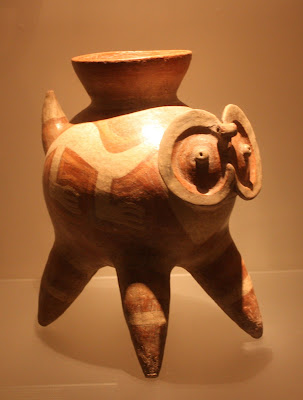After a quick trip to the clinic to pick up Bill and have the doctor diagnose Diane with "Acute Mountain Sickness" (even after the altitude meds.) we were off on our tour for the day! (One of the women on the trip gave Diane some OTC mountain sickness meds. and she was felling better 1/2 hour after taking one!)


Our first stop was the local market where you can get all sorts of things. We are not showing some of the things out of sensitivity to our friends' stomachs.


We took a bus to visit Sacsayhuaman, an Incan fortress with massive granite rocks which weigh up to 130 tons and up to 9 meters tall. The rocks were fit together like puzzle pieces, with no mortar holding them together. The walls were built in a zig-zag shape. Sacsayhuaman was a ceremonial structure composed of plazas, fountains and subterranean passageways. There are excavations still underway here, recent findings being ritual offerings and the base of two circular towers. It is difficult to imagine how huge these walls are and how long the structure is by the pictures we took with our vantage point (you can find one which was created by stitching photos together on the
wikipedia entry.)

Next we stopped at a viewpoint to see the city of Cusco from the hills.
Qorikancha was the most important Incan temple where priests worshiped the sun god and other deities. During Pachacutec the temple was given its name meaning "gold enclosure" referencing the gold it was decorated with. When the Spanish arrived they dedicated it to Christian worship. They built the Dominican church/monastery on top of the foundations of the Inca Temple and modified the interiors. All of the gold was taken by the Spanish. The interiors had rich Spanish/Quechua paintings as well as preserved Incan rooms. The local artists were pressed into service copying Spanish paintings, but usually managed to sneak in some symbol or object that meant something to the Inca.
 |
| Qorikanche/Santo Domingo - layers of foundations |
 |
| Terraces from Incan times |
 |
| Cloisters |
 |
| Cloisters |
We went by bus through the Plaza de Armas which has both the Cathedral and the Jesuit Church. We toured the Cathedral which was beautiful and very ornate (no pictures allowed.) The rain came down and we show you some not so great pictures...
 |
| Cathedral |
 |
| Jesuit Church |
 |
| Plaza de Armas |

 |
| One of the beautiful courtyards in the hotel and cloisters. |
In the evening we were treated to a program on Andean Indigenous Instruments by Kike Pinto, PhD. It was held in the chapel of the Monestario Hotel. Kike Pinto has collected over 7500 indigenous instruments and started a museum. He performs as well as delivers educational programs to schools and other groups like ours. Kike said the he is preserving music from the ancestors and that the applause goes to the ancestors and native people keeping the music alive. He played instruments made from deer antlers, rattles from gourds with seeds, flutes (2 hole, 5 hole, double flute, various octaves, some ceremonial, different sounds, bamboo, balsa, condor, horizontal/vertical), Pan flutes, Charango (little guitar), conch shell, and drums. There was more, but you get the idea. It was mesmerizing and very beautiful. The first two pictures are ours of that night and the remainder are from Kike Pinto's Facebook Page! (
He's also on MySpace so you can hear samples.) Here is a link to the
Instituto Taki Museum where are there are more pictures of instruments.
 |
| Kike Pinto |
 |
| Pan Flute |
Cusco is nicknamed "The Navel of the World". It is a beautiful city and we had far too short of a time there. It was the capital of the Incas. We would be happy to visit Cusco again.
 Our alarm was set for 3:30 AM to put our suitcases out in the hall and get ready to leave the Miraflores Hotel. This was one of the nicest hotels we stayed in though there were so many nice places we stayed. It reminded us of our Intercontinental Hotel in Panama City with a beautiful park between the hotel/highway and the water. Beautiful.
Our alarm was set for 3:30 AM to put our suitcases out in the hall and get ready to leave the Miraflores Hotel. This was one of the nicest hotels we stayed in though there were so many nice places we stayed. It reminded us of our Intercontinental Hotel in Panama City with a beautiful park between the hotel/highway and the water. Beautiful.

















































